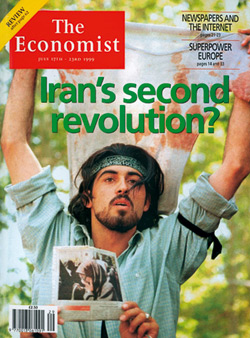 Jon Weinberg is a research intern with the New America Foundation’s Middle East Task Force.
Jon Weinberg is a research intern with the New America Foundation’s Middle East Task Force.
Yesterday marked the tenth anniversary of the 1999 student protests in Iran. The protests, which began with the government shutdown of the reformist newspaper, Salam, bear several striking resemblances to those that have taken place in the aftermath of the country’s recent June elections.
Nevertheless, perhaps the greatest disparity between the current Iranian protests and those of a decade ago is the existence of websites like YouTube, Twitter, and Facebook. These websites keep Iranian protesters informed about their progress and give the world a firsthand account of what is happening on the ground.
During the July 1999 protests 21 year-old Ahmad Batari became his movement’s de facto poster child for appearing on the cover of that week’s Economist holding a blood-spattered t-shirt of a fellow protester.
In some ways, this image of Batari offers a salient parallel to the video footage of Neda Agha-Soltan (known by her admirers and mourners simply as “Neda”), taken on June 20th when the 27 year-old aspiring singer was shot during while peacefully protesting in Tehran.
Yet, it is the stark contrasts between Ahmad’s and Neda’s stories that highlight why the events of the past four weeks do not have as strong of a historical precedent as many believe. In 1999, the Iranian government could effectively restrict communication and media outlets. Those were the days when journalists and the rest of the world had to settle on an old photograph of Batari and the bloodied shirt.
Now, two videos of Neda’s death are circulating around the internet. News of the videos spread like wildfire, mostly via Twitter after the government disabled SMS texting. On July 3rd, a third video–which was taken from a rooftop–emerged on YouTube confirming Neda was guilty of little more than proximity to a crowd shouting marg bar dictator!— “Death to the dictator!”
I have no doubt that similar, though hopefully less tragic, footage will emerge from yesterday’s protests. Again, young Iranians have gathered around Tehran University chanting “Death to the dictator.” This time, protesters were met with tear gas and nightsticks instead of bullets, perhaps as a result of the Neda videos.
Thus, despite President Mahmoud Ahmadinejad ostensible electoral victory, it is to their disadvantage that the Iran that they control is fundamentally different than the Iran of 1999. Even if Ahmadinejad’s supporters can prove the election results of June 12th, in all probability it will only get easier for the tens of millions of Iranian dissidents to make themselves heard–and even easier for anyone with an internet connection to hear them.
— Jon Weinberg


63 comments on “Guest Post by Jon Weinberg: A Decade Makes a Difference”